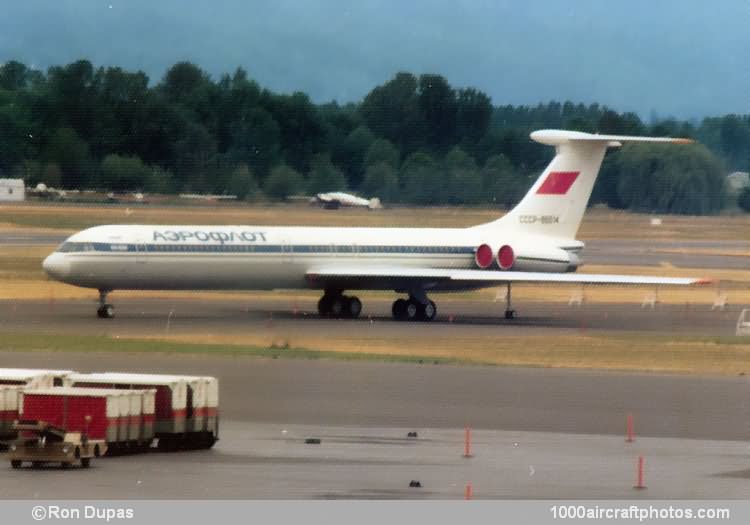08/31/2014. Remarks by Johan Visschedijk: "The Ilyushin Il-62 occupied an important niche in Soviet aviation history as that country's first true long-range four-engined jet transport, and also the first Soviet rear-engined civil aircraft to get into production. There was much controversy in 1962, with the revealing of the first details of the Il-62 in the Russian press, of the similarities between the Russian aircraft and the slightly earlier British VC-10 developed by Vickers and produced by the British Aircraft Corporation, In this instance, though, it seems clear that similar airline requirements had given rise to a close similarity of design philosophy: four engines mounted in pods in pairs at the rear of the fuselage to leave the wing aerodynamically clean for maximum efficiency; large wing area to ensure minimum runway requirements; 32.5 to 35% of wing sweep for high-speed cruising; and a T-tail to leave the rear fuselage clear for the engines.
Revealed on September 24, 1962, when the prototype was inspected by Nikita Khrushchev, the Il-62 first flew in January 1963, the delay probably being occasioned by the unavailability of the Kuznetsov NK-8, which had been designed for use in the Il-62. With the adoption of a drooped saw-tooth extension of the outer two-thirds of the leading edges, the low-speed problem was apparently solved, and the test program, involving two prototypes and three pre-production aircraft, then moved ahead satisfactorily. Production of the Il-62 for Aeroflot began at Kazan in 1965, and during 1966 the airline operated a small number of aircraft on proving flights, the most notable being the 3,822 mls (6,150 km) between Moscow and Khabarovsk in eastern Siberia in 8 hours at an average speed of almost 478 mph (770 kmh).
The first scheduled services flown by the Il-62 were those between Moscow and Khabrovsk, and between Moscow and Novosibirsk, started on March 10, 1967. The first international service was between Moscow and Montreal, inaugurated on September 15, 1967 for Expo '67. Maximum capacity of this initial model was 186 economy-class passengers, plus up to 1,695 cu.ft (48 cu.m) of baggage, the latter being loaded in only fifteen minutes thanks to the use of special pre-packed containers. Maximum payload was 50,706 lb (23,000 kg).
Early operations confirmed that the operating economics of the Il-62 were poor, largely as a result of the marginal performance of the NK-8-4 turbofans. In 1970, therefore, the USSR announced a new model, the Il-62M200 or Il-62M. This first appeared in 1971, and was dimensionally identical with its predecessor. The main differences between the two types lie in the Il-62Ms new power plant and extra fuel capacity. That engine was the 25,353 lb (11,500 kg) Soloviev D-30KU turbofan. The outer pair of engines were fitted with clamshell-type thrust reversers in place of the cascade type used in the Il-62, with consequent improvements in the Il-62Ms landing performance. The Il-62M also featured an extra fuel tank, located in the fin and capable of holding 1321 gal (5,000 l), which helped to give the Il-62M a maximum payload range 808 mls (1,300 km) greater than the Il-62.
The last version of this important Russian transport was the Il-62MK, announced in 1978. This was basically the Il-62M with a strengthened airframe for high-frequency operations, derated D30KU engines, a passenger capacity of up to 195, compared with the Il-62Ms 186, maximum take off weight increased by 4409 lb (2,000 kg) from 363,759 lb (165,000 kg), maximum payload also increased by 4,409 lb (2,000 kg), and range with a 22,046 lb (10,000 kg) payload reduced by only 249 mls (400 km).
In all 292 Il-62s were built, including some unsold airframes built in the 1990s. The pictured aircraft was delivered to Aeroflot in December 1980, when the USSR broke up the aircraft was registered in Russia as RA-86514, by March 1996 it was withdrawn from use and was subsequently scrapped."
